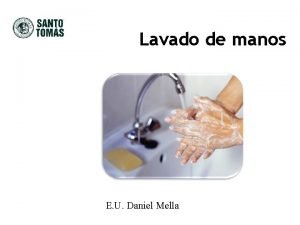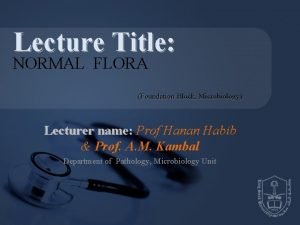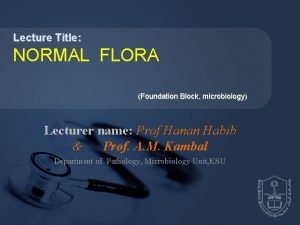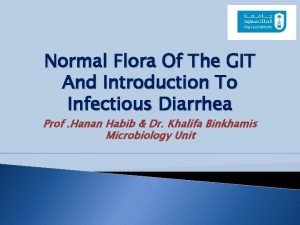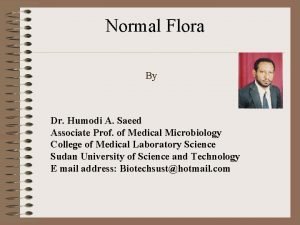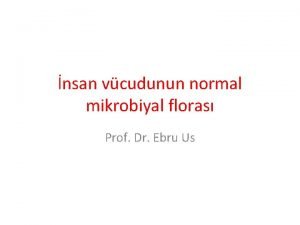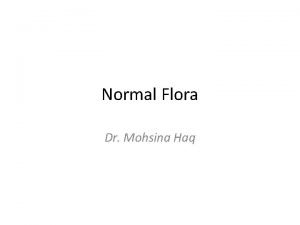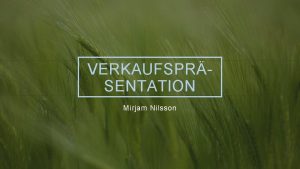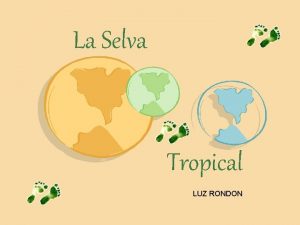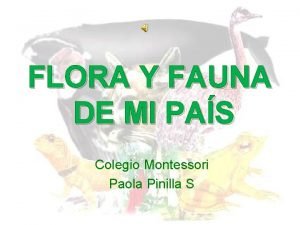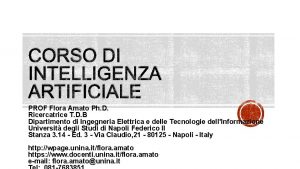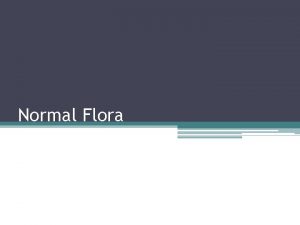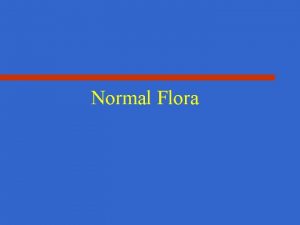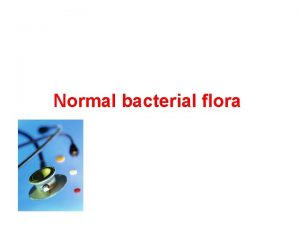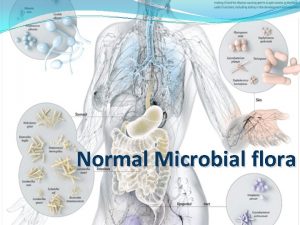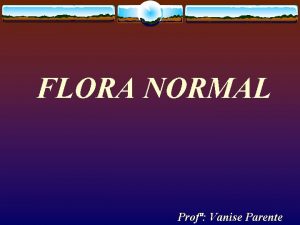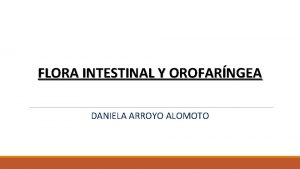Normal flora Normal flora 1 Definition Normal flora






































- Slides: 38

Normal flora

Normal flora 1 Definition • Normal flora is the mixture of microorganisms (bacteria and fungi) that are regularly found at certain anatomical site of human body without causing disease. • Called Microbiota, Microflora, Microbial flora, Indigenous microbial population • There are more bacteria (1014) living in or on our bodies, than we have cells (1013) of our own.

Normal Flora 2

Normal Flora 3 • • Skin Eyes (i. e. Conjunctiva) Nose (i. e. Respiratory tract) Mouth (i. e. Human Oral Cavity) Ears Urogenital tract Elementry tract


Estimation of Normal flora • Estimated human normal flora; – 1012 bacteria on the skin, – 1010 in the mouth, and – 1014 in the GIT.

Normal Flora 3 • Resident flora – Acquired rapidly during & after birth – Changes continuously through out life Reflects a person’s - Environment (90% is S. epidermidis; S. aureus, may be in moist areas) -Culture -Sex -Age -Nutrition -Genetics -Use of antibiotics

Normal flora 4 Sterile tissues In a healthy human, the internal tissues such as: • Blood • Brain • Muscle • Cerebrospinal fluid (csf) are normally free of microorganisms.

Normal Flora of the Conjunctiva - Staphylococcus epidermidis - Corynebacterium sp. - Propoinibacterium acnes - Staphylococcus aureus - Viridans streptococci - Neisseria sp. - Haemophilus influenzae Pathogens of the conjunctiva • Neisseria gonorrhoeae • Chlamydia trachomatis

Normal flora of the skin 1 • The most important sites are: – Axilla – Groin – Areas between the toes • The majority of skin microorganisms are found in the most superficial layers of the epidermis and the upper parts of the hair follicles.

Normal flora of the skin 2 • Important bacteria: 1. Staphylococcus epidermidis 2. Micrococcus sp. 3. Corynebacteria sp. 4. Mycobacterium smegmatis

Normal Flora of the Respiratory Tract 1 Nostrils - Staphylococcus epidermidis - Corynebacteria - Staphylococcus aureus - Neisseria sp. - Haemophilus sp - Streptococcus pneumoniae

Normal Flora of the Respiratory Tract 2 The upper respiratory tract (nasopharynx). - Non-hemolytic streptococci - Alpha-hemolytic streptococci - Neisseria sp. - Streptococcus pneumoniae - Streptococcus pyogenes - Haemophilus influenzae - Neisseria meningitidis

Normal Flora of the Respiratory Tract 2 The lower respiratory tract (trachea, bronchi, and pulmonary tissues): • Usually sterile. • The individual may become susceptible to infection by pathogens descending from the nasopharynx e. g. – H. influenzae • S. pneumoniae).

Normal Flora of the Respiratory Tract 3 The lower respiratory tract (trachea, bronchi, and pulmonary tissues): • Usually sterile • The individual may become susceptible to infection by pathogens descending from the nasopharynx e. g. – H. influenzae – S. pneumoniae.

Normal Flora of the Human Oral Cavity 1 Oral bacteria include: Viridans streptococci Lactobacilli Staphylococci (S. aureus and S. epidermidis) - Corynebacterium sp. - Bacteroides sp. - Streptococcus sanguis (dental plaque) - Streptococcus mutans (dental plaque) - Actinomyces sp. • -

The Normal Flora of The External Ear • The external ears contains a variety of microorganisms. These include: - Staphylococcus epidermidis. - Staphylococcus aureus - Corynebacterium sp

Normal flora of the Urogenital Tract 1 The anterior urethra - Staphylococcus epidermidis - Enterococcus faecalis - Alpha-hemolytic streptococci. - Some enteric bacteria (e. g. E. coli, Proteus sp. ) - Corynebacteria sp. - Acinetobacter sp. - Mycoplasma sp. - Candida sp. - Mycobacterium smegmatis

Normal flora of the Urogenital Tract 2 The vagina - Corynebacterium sp. - Staphylococci - Nonpyogenic streptococci - Escherichia coli - Lactobacillus acidophilus - Flavobacterium sp. - Clostridium sp. - Viridans streptococci - Other Enterobacteria

Normal flora of the Human Gastrointestinal Tract 1 • At birth - The entire intestinal tract is sterile, but bacteria enter with the first feed. - The initial colonizing bacteria vary with the food source of the infant.

Normal flora of the Human Gastrointestinal Tract 2 • In breast-fed - Bifidobacteria account for more than 90% of the total intestinal bacteria. - Enterobacteriaceae - Enterococci - Bacteroides - Staphylococci - Lactobacilli - Clostridia

Normal flora of the Human Gastrointestinal Tract 3 • In bottle-fed infants - Bifidobacteria are not predominant. When breast-fed infants are switched to a diet of cow's milk or solid food, bifidobacteria are progressively joined by: - Enterics Bacteroides Enterococci Lactobacilli Clostridia

Normal flora of the Human Gastrointestinal Tract 2 • In the upper GIT of adult humans – mainly acid-tolerant lactobacilli e. g. Helicobacter pylori • The proximal small intestine – – Lactobacilli Enterococcus faecalis Coliforms Bacteroides

Normal flora of the Human Gastrointestinal Tract 2 The flora of the large intestine (Colon) - Enterococci - Clostridia - Lactobacilli - Bacteroides - Bifidobacterium (Bifidobacterium bifidum) - Escherichia coli - Methanogenic bacteria - Viridans streptococci - Staphylococcus sp. - Proteus sp. - Candida albicans (Yeast) - Mycoplama sp.

Normal flora (Advantages) • Protective host defense mechanism by occupying ecological niches. • Contribute to immunity by inducing low levels of circulating and secretory antibodies that may cross react with pathogens • Produce vitamin B and vitamin K in intestine. • Exert microbial antagonism against non-indigenous species by production of inhibitory fatty acids, peroxides, bacteriocin, etc.

Normal flora (Disadvantages) Cause disease/harm in: - Immunocompromised or debilitated individuals. - When they change their usual anatomic location. - Since some of these bacteria are pathogens or opportunistic pathogens Clinical conditions that may be caused by normal flora

Normal flora and Mood • Normal flora influence human physiology • Micro-organisms in our gut secrete a profound number of chemicals used by our neurons to communicate and regulate mood, like dopamine, serotonin and gamma-aminobutyric acid (GABA). • These, in turn, appear to play a function in intestinal disorders, which coincide with high levels of major depression and anxiety.

Opportunistic flora

Opportunistic flora 1 • Some normal flora become opportunistic pathogens • (Staphylococcus aureus, Streptococcus mutans, Enterococcus faecalis, Streptococcus pneumoniae, Pseudomonas aeruginosa, etc. ) • Breach of skin/mucosal barrier: trauma, surgery, burns • Bacterium at one site may be commensal, but pathogenic at another site

• Other risks: Opportunistic flora 2 – Dental plaque – Dental caries: destruction of enamel, dentin or cementum of teeth – Periodontal disease – Inflammatory bowel disease – Obesity

Opportunistic flora 3 • Other risk factors include – Broad-spectrum antibiotic therapy decreases total number of bacterial in gut • During repopulation, fastergrowing aerobic Enterobacteriaceae over slower-replicating anaerobes increases probability of gram -negative bacteremia – Cross-reactive responses to host tissue: Superantigen – Chronic, low-grade inflammation • Perturbation of cytokine network

Probiotics/Prebiotics

Probiotics/Prebiotics • Probiotic – Oral administration of living organisms to promote health – Mechanism speculative: competition with other bacteria; stimulation of nonspecific immunity – Species specific: adherence and growth (tropism) – E. g. S. boulardii, lactobacillus acidophilus • Prebiotic – Non-digestible food that stimulates growth or activity of GI microbiota, especially bifidobacteria and lactobacillus bacteria (both of which are non-inflammatory) – Typically a carbohydrate: soluble fiber

Advantages of Probiotics

Disadvantages of Probiotics • Could cause – Infections in immunosuppressed individuals – Digestive issues such as gas and bloating which may be temporary, – Complication of certain ill health condition such as pancreatitis.

Gnotobiology 1 • Refers to – A microbiologically monitored environment or animal that is germfree (axenic) – animal in which the identities of all normal flora are known – Helps to investigate the interactions of animals and specific microorganism

Gnotobiology 2 Fetus is sterile • Cesarean sections to obtain fetus • Fetus growing in sterile isolator • Not anatomically or physiologically normal – Poorly developed lymphoid system, thin intestinal wall, enlarged cecum, low antibody titers – Die of intestinal atonia (motility problem) – Require vitamin K and B complexes • More susceptible to infection • Almost completely resistant to the intestinal protozoan Entamoeba histolytica (amebic dysentery) • No dental caries or plaque (except if inoculated with cariogenic streptococci of the Streptococcus mutans. Streptococcus gordonii)

 Cuanto dura un lavado de manos clinico
Cuanto dura un lavado de manos clinico Fauna de zona sur
Fauna de zona sur Benefits of normal flora to the human body
Benefits of normal flora to the human body Normal flora definition
Normal flora definition Normal flora definition
Normal flora definition Definition of normal flora
Definition of normal flora Flora git
Flora git Git
Git Solunum yolu flora bakterileri üredi
Solunum yolu flora bakterileri üredi Normal flora of oral cavity
Normal flora of oral cavity Normal flora of respiratory tract
Normal flora of respiratory tract It's normal to be normal
It's normal to be normal Welcome to my english class
Welcome to my english class Flora and farabi passage
Flora and farabi passage Farabi and flora
Farabi and flora Flora berggren
Flora berggren Flora e fauna colline
Flora e fauna colline Peta persebaran flora dan fauna di indonesia
Peta persebaran flora dan fauna di indonesia Savany flora
Savany flora Savana fauna
Savana fauna Savana flora
Savana flora Recursos renovables flora
Recursos renovables flora Mirjam nilsson
Mirjam nilsson Flora berggren
Flora berggren Macchia mediterranea bioma
Macchia mediterranea bioma Selva pluvial mesotérmica o selva nublada
Selva pluvial mesotérmica o selva nublada Tranziens flóra
Tranziens flóra Il tevere flora e fauna
Il tevere flora e fauna Lesbia's sparrow
Lesbia's sparrow Flora zona central
Flora zona central De la zona sur
De la zona sur Flora e fauna del fiume
Flora e fauna del fiume Fauna e flora do acre
Fauna e flora do acre Slidetodoc. com
Slidetodoc. com Estonia flora e fauna
Estonia flora e fauna Flora sandes
Flora sandes Dünya flora alemleri
Dünya flora alemleri Flora amato unina
Flora amato unina August bergqvist
August bergqvist
